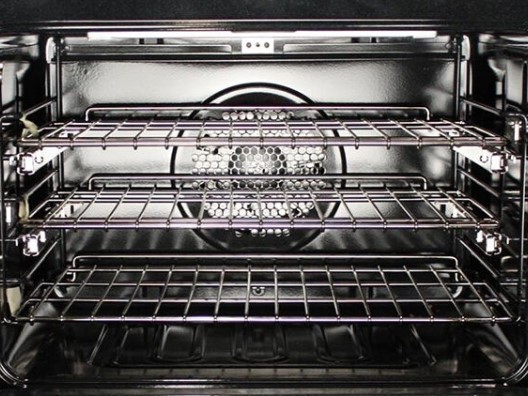How Does a Self Cleaning Oven Work?
Posted on September 20, 2023 By Alison P
Short answer: Heat, and lots of it!
Slightly longer answer: An oven's self-cleaning function uses scorching-hot temperatures to disintegrate the food debris that's dirtying up the interior, saving you the trouble of tedious scrubbing with harsh chemical cleaners. This function usually takes several hours from start to finish, with the oven door automatically locked for safety the entire time. While self cleaning ovens are incredibly convenient and can save plenty of time and effort, there are some important points to be aware of to maximize safe operation. Here are some key tips for using a self cleaning oven!
Table of Contents
- How Hot Does a Self Cleaning Oven Get?
- How Often Should You Use the Self-Cleaning Function?
- Key Instructions for Safely Using a Self-Cleaning Oven
- Should You Use Oven Cleaner on a Self-Cleaning Oven?
- Can You Leave Oven Racks In During Self Cleaning?
- Are There Any Risks with Using a Self-Cleaning Oven?
- What to Do When the Self-Cleaning Cycle Is Done
How Hot Does a Self-Cleaning Oven Get?
An oven's temperature in self-cleaning mode can exceed 900 degrees Fahrenheit - that's hotter than the surface of the planet Venus! This is why we recommend your oven's self-cleaning sessions be few and far between. The heating element inside your oven has to work extremely hard to reach the excessive temperatures needed for a self cleaning cycle, and if you don't want it to completely burn out, getting it hot enough to melt lead shouldn't become a habit.
How Often Should You Use the Self-Cleaning Function?
We'd recommend once every six months, but spacing them out further isn't a bad idea. You can clean your range between self-cleaning sessions by using water and a mild detergent, or an oven cleaner that's specially formulated for use in a self cleaning electric or gas oven.
Key Instructions for Safely Using a Self-Cleaning Oven
First and foremost, don't leave your oven unattended during self-cleaning. You should plan to be in your home for the entire duration of the cleaning cycle to keep an eye on it and make sure everything is operating as planned. The next most important rules for oven self-cleaning involve ventilation. The extreme heat of the self-cleaning cycle creates fumes and some smoke, so be sure to turn on your kitchen's range hood and open your kitchen windows as wide as weather permits. If you have pets, be mindful that their sense of smell is probably much stronger than yours, and make sure they have access to fresh air while the cleaning cycle is happening. This is especially true if you have pet birds - be sure to keep them in a separate room with good ventilation while your oven is self-cleaning.
 Should You Use Oven Cleaner on a Self-Cleaning Oven?
Should You Use Oven Cleaner on a Self-Cleaning Oven?
Bad idea! Traditional oven cleaners can be terribly dangerous to use inside a self-cleaning oven. These types of cleaners are extremely abrasive, and any lingering residue inside your oven can create dangerous fumes when you do use the self-cleaning function in the future. Cleaning your oven the old-fashioned way should involve nothing more than a soft cloth, water, and mild dish soap or baking soda. There are also special oven cleaners that are formulated specifically for use in self cleaning ovens. We advise against using scouring pads or wire brushes due to the potential for permanent damage to the oven's finish.
Can You Leave Oven Racks In During Self-Cleaning?
Oven racks should definitely be removed before beginning a self-cleaning cycle. Nothing catastrophic will happen if you do forget to remove them, but the exposure to extreme heat for such a long period of time will do major damage to the racks' finish. Oven racks that are ceramic or porcelain-coated will fare much better in a self-cleaning cycle, but you should make it a point to clean any residue off of them as soon as the self-cleaning cycle is complete.
Are There Any Risks with Using a Self-Cleaning Oven?
The biggest concern people tend to have when it comes to self-cleaning ranges or wall ovens is the risk of fire. Since the objective of self-cleaning is to burn off food debris, it's normal to see some small flames here and there inside of your oven. However, if an oven is excessively soiled, it is possible for a larger fire to break out. This can be prevented by cleaning up any excessive grime in the oven's interior before doing a self-cleaning cycle.
The oven's door lock engages during the self-cleaning cycle, which ensures safe containment in the event of flare-ups, so that usually will keep any larger fire contained. If any flames reach outside the oven, cut the power to the oven as quickly as possible, and have baking soda or a fire extinguisher at the ready. Again, self cleaning oven dangers are significantly lessened if your oven is not heavily soiled.
What to Do When the Self-Cleaning Cycle Is Done
Be sure to let the oven cool down completely before you do anything! As we said earlier, self-cleaning cycles can reach temperatures of over 900 degrees Fahrenheit, so be patient as it may take a while for the oven to completely cool down. Once it's cool, use a damp cloth to wipe up any ash left behind. Again, we advise against using scouring pads or wire brushes due to the potential for damage to your oven's finish.
Instead of having to deal with the hassle of scrubbing or the unpleasantness of oven cleaner fumes, bring home the hands-off convenience of a self cleaning oven or range, and enjoy the time you save!